Kontron fields bevy of Sandy Bridge boards
Mar 4, 2011 — by LinuxDevices Staff — from the LinuxDevices Archive — 7 viewsKontron announced a quartet of boards featuring Intel's “second generation” Core processors. They include the KTQM67M/mITX Mini-ITX board, the KT67/FLEX FlexATX board, the CP6003-SA CompactPCI board, and the VX3035 VPX board, according to the company.
Intel announced its "Sandy Bridge" CPUs starting with a pre-Consumer Electronics Show launch that included 15 new mobile processors and 14 new desktop CPUs; six embedded-specific offerings came to light later via vendor announcements. We still cavil at the description of these Core processors as merely the "second generation," but are about ready to throw in the towel thanks to the constant repetition of this claim by third parties — including Kontron.
Whatever generation you consider them, the 32nm Sandy Bridge chips have a new microarchitecture, a 256-bit instruction set known as AVX (advanced vector extensions), enhanced GPUs (graphics processing units), and dedicated silicon for tasks such as transcoding video from one format to another. The devices require only simple I/O controllers, offered in at least ten models (the Q67, H67, H61, QM67, HM67, P67, HM65, B65, and QS67) collectively code-named Cougar Point.
Unfortunately, Intel found a flaw in Cougar Point that it disclosed at the end of January, explaining that the controllers' 3Gbps SATA ports could deteriorate over time and ultimately lead to any connected drives becoming totally inaccessible. The chipmaker says it will continue to supply flawed parts to vendors who promise not to use 3Gbps SATA, is now shipping some redesigned ones, and will be back to providing the originally envisaged volumes in April.
Kontron, meanwhile, quickly adopted one of the new Sandy Bridge Cores (the 2.1GHz Core i7-2715QE, along with the QM67 Express chipset) for the ETXexpress-SC COM Express module it announced in early January. At the time, the company said it would release additional Sandy Bridge devices during the first quarter, including mini-ITX and Flex-ATX motherboards, as well as a 6U CompactPCI blade.
Now, in conjunction with this week's Embedded World event in Nuremberg, Germany, Kontron has popped out all three of the above as well as a VPX board. Apparently the manufacturer is confident that it has a sufficient supply of rectified Cougar Point I/O controllers on hand.
KTQM67M/mITX Mini-ITX board
The KTQM67M/mITX uses the 6.7 x 6.7-inch Mini-ITX form factor and employs the QM67 Express chipset, according to Kontron. The specific Sandy Bridge models supported are not listed, but the board supports Core i3, i5, and i7 models with dual or quad cores, with clock speeds up to 3.1GHz, the company says.
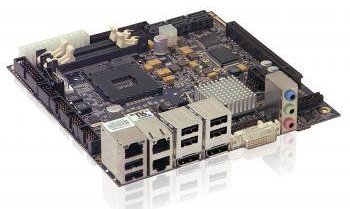
Kontron's KTQM67M/mITX
According to Kontron, the KTQM67M/mITX accepts up to 16GB of DDR3 RAM via two DIMM slots, and has six SATA ports (four 3Gbps, two 6Gbps) with RAID support. Further storage expansion is provided in the form of an mSATA connector for a solid state disk, as well as an IEEE1394 port, adds the company.
Kontron says the KTQM67M/mITX has one PCI Express x16 expansion slot, one PCI Express x1 slot, and two Mini PCI Express slots. Rear panel connectors are said to include three gigabit Ethernet ports, six USB ports, two DisplayPorts, a DVI-I output, and audio I/O.
Internal headers on the KTQM67M/mITX include a PS/2 mouse/keyboard connector and eight more USB 2.0 ports, says Kontron. Compatible with Linux, Windows 7, Windows Vista, Windows XP, Windows Embedded Standard 7, and VxWorks, the board features a trusted platform module, the company adds.
Further information may be found on the KTQM67M/mITX product page.
KT67/FLEX FlexATX board
Kontron's KT67/FLEX employs Intel's 9.0 x 7.5-inch FlexATX format, which gives the board room for two 32-bit PCI expansion slots, one PCI Express x4 slot, and one Mini PCI Express slot. Here, there's also provision for up to 32GB of DDR3 RAM via four DIMM slots, according to the company.
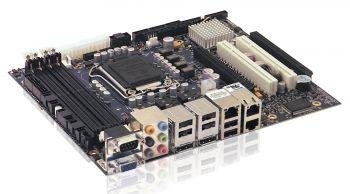
Kontron's KT67/FLEX
Kontron says the KT67/FLEX employs Intel's Q67 Express chipset and again supports various Core i7, i5, and i3 processors — still not specified, though maximum clock speed is 3.8GHz. Six SATA ports (four 3Gbps, two 6Gbps) once more supply RAID support, while an mSATA connector supports an SSD, the company adds.
Rear panel connectors are said to include a serial port, a VGA port, two DisplayPorts, six USB 2.0 ports, and three gigabit Ethernet ports. According to Kontron, there are also six 3.5mm jacks for multiple-channel analog audio.
Internally, the board has headers for eight additional USB 2.0 ports. It's also said to have a "KT feature connector," a proprietary Kontron offering intended for unspecified accessories.
Again, the board is said to be compatible with Linux, Windows 7, Windows Vista, Windows XP, Windows Embedded Standard 7, and VxWorks. Further information may be found on the KTQ67/FLEX product page.
CP6003-SA CompactPCI board
The CP6003-SA is a 6U CompactPCI board that may be used in a system slot or, in passive mode, in a peripheral slot, according to Kontron. It includes the QM67 Express chipset and supports Core i7 processors in quad-core versions up to 2.1GHz, and dual-core versions up to 2.5GHz, the company adds.
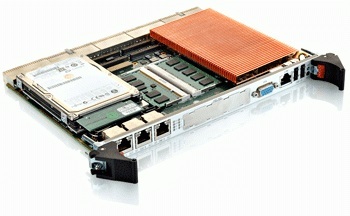
Kontron's CP6003A
Kontron says the device's two DIMM slots support up to 16GB of DDR3 memory, while there's also the option of an SSD up to 32GB in size. Additionally, the company says, there are six SATA ports: one reserved for an onboard, 2.5-inch disk drive, one routed to a standard SATA connector, and four sent over the cPCI connector.
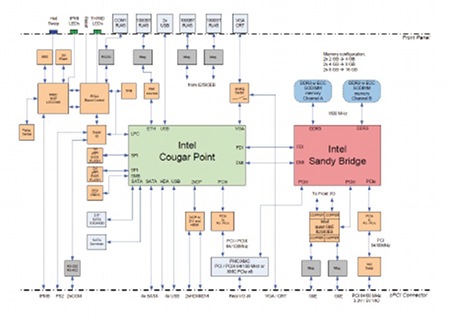
A block diagram of Kontron's CP6003SA
(Click to enlarge)
Front-panel functionality is said to include three gigabit Ethernet ports, a serial port that also uses an RJ45 connector, two USB 2.0 ports, and a VGA output. Routed to the rear, meantime, are two more gigabit Ethernet ports, another serial port, a PS/2 port, and four more USB 2.0 ports, according to Kontron.
A PMC socket for mezzanine cards provides 64-bit, 133MHz expansion, while an XMC socket employs PCI Express x8. An optional Trusted Platform Module (TPM) 1.2, two redundant firmware hubs (failover) and Intelligent Platform Management Interface (IPMI) are all supported, according to Kontron.
Kontron says the CP6003-SA runs Linux, Windows 7, Windows Embedded Standard 7, Windows XP, XP Embedded, Windows Server 2008 R2, or VXWorks. Highly integrated board support packages support all onboard hardware devices as well as specific features like hot swap, IPMI, power, and thermal management, the company adds.
Further information may be found on the CP6003-SA product page.
VX3035 VPX board
Kontron touts its VX3035, a 3U VPX CPU board, as "defining a new performance class for SWaP (size, weight and power)" in the military and aerospace market. This device uses the QM67 Express chipset along with the 2.2GHz Core i7-2655LE, which features dual cores and a 25-Watt TDP, according to the company.
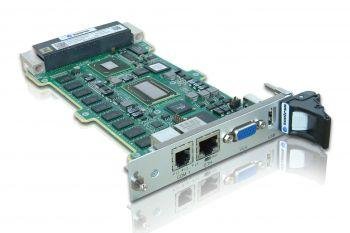
Kontron's VX3035
The VX3035 is available with up to 8GB of soldered-on DDR3 memory, and there's also a mezzanine socket that can accept USB or SATA flash modules (typical capacities are 8GB, 16GB, or 32GB), says Kontron. Four SATA interfaces travel via the backplane and support drive arrays in RAID 0/1/5/10 configurations, the company adds.
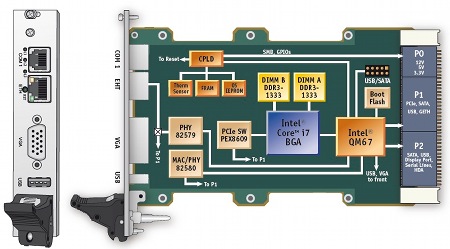
The front panel and a block diagram of Kontron's VX3035
(Click to enlarge)
According to Kontron, the VX3035's front interfaces include a VGA port, a gigabit Ethernet port, a USB 2.0 port, and a serial port with an RJ11 connector. Three additional gigabit Ethernet ports and up to five PCI Express lanes travel over the backplane, the company further says.
Kontron says the VX3035 is available in a standard commercial version that has a 32 to 104 deg. F operating range and requires forced air cooling. Also available are rugged air-cooled and convection cooled versions that provide operating ranges of -40 to 158 deg. F or -40 to 158 deg. F, respectively.
Supported operating systems include Linux, Windows Embedded Standard 7, and VXWorks, according to Kontron. Further information may be found on the VX3035 product page.
This article was originally published on LinuxDevices.com and has been donated to the open source community by QuinStreet Inc. Please visit LinuxToday.com for up-to-date news and articles about Linux and open source.